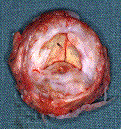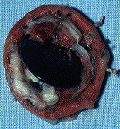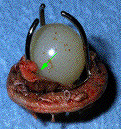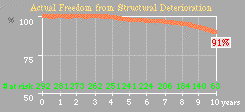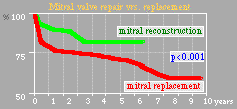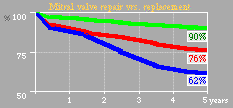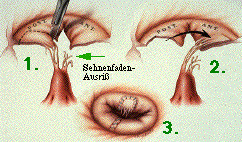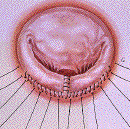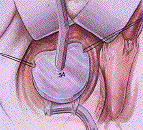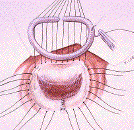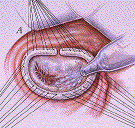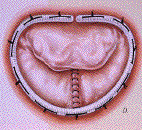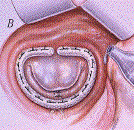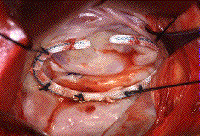historical note:
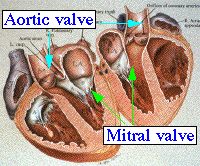 In 1913, Doyen
unsuccessfully attempted to relieve pulmonary stenosis with tenotome. 1914,
Tuffier successfully relieved 1 case of aortic stenosis with finger
dilatation. From 1923 to 1928 Cutler and Souttar reported 10 cases of mitral
stenosis surgery - only 2 patients survived these attacts. In 1948, Harken
and Bailey, from Boston and Philadelphia, performed their 1st transatrial
commissurotomies to treat mitral valve stenosis. John Gibbon performed the
1st successful open-heart operation on a human patient using a heart-lung
machine on May 6, 1953, starting the age of open heart surgery. Lillehei is
credited with successfully completing the 1st surgical correction of mitral
valve insufficiency in 1956. The 1st reported mitral valve replacement took
place on July 22, 1955 in England, with Judson Cheesterman performing the
surgery.
In 1913, Doyen
unsuccessfully attempted to relieve pulmonary stenosis with tenotome. 1914,
Tuffier successfully relieved 1 case of aortic stenosis with finger
dilatation. From 1923 to 1928 Cutler and Souttar reported 10 cases of mitral
stenosis surgery - only 2 patients survived these attacts. In 1948, Harken
and Bailey, from Boston and Philadelphia, performed their 1st transatrial
commissurotomies to treat mitral valve stenosis. John Gibbon performed the
1st successful open-heart operation on a human patient using a heart-lung
machine on May 6, 1953, starting the age of open heart surgery. Lillehei is
credited with successfully completing the 1st surgical correction of mitral
valve insufficiency in 1956. The 1st reported mitral valve replacement took
place on July 22, 1955 in England, with Judson Cheesterman performing the
surgery. artificial valves:
|
|
|
Biological valves: The most frequent cause of bioprosthetic valve failure is primary tissue degeneration. Toxic preservation and the lack of viable autologous endothelial cells on the leaflet surfaces may be responsible for degeneration and calcification. In the past few years research interest was focused on new techniques to improve conventional bioprostheses by studying possible alternative methods of preservation and in vitro endothelialization, elimination of toxic agents and antimineralization. |
| degeneration of biological valves: left slide: leaflet rupture right slide: tissue overgrowth & calcification. | ||
| Mechanical valves:
The most frequent limitations of mechanical valves
are primarily related to thromboembolism and anticoagulant-related
hemorrhage. Mechanical valves will not undergo degeneration, like
biological valves. Nevertheless, complications related to
thromboembolism and anticoagulant therapy are to be considered if
deciding which valve to implant. complications of mechanical valves: left slide: thrombotic occlusion of a mechanical disc valve right slide: thrombosis of a cached ball mechanical valve (<-) |
|
|
mitral valve replacement vrs. valve repair:
|
|
slide left: "Actual freedom from structural deterioration" Clinical data of the durability of the biological Carpentier Pericardial Valve. The 10 year actuarial freedom from structural deterioration was 91%. Sem Thorac Cardiovasc Surg 1966;8:269-275 | |
| slide right:"Freedom from all valve related complications" Freedom from all valve-related complications, according to valve position after mechanical heart valve replacement. (red: mitral valve; green: aortic valve; blue: doubble valve) J Thorac Cardiovasc Surg 1990;100:44-55 |
|
|
|
|
slide left: "Mitral valve repair vrs. replacement" Actuarial survival from all cardiac-related death after mitral valve repair vrs. mechanical heart valve replacement. (green: mitral reconstruction; red: mitral replacement) Ann Thorac Surg 1989;47:655-662 | |
| slide right:"Mitral valve repair vrs. replacement" Five year actuarial survival after mitral valve repair (green) (annuloplasty), valve replacement with a mechanical valve (red), and with a bioprosthesis (blue). Europ J Cardio-thorac Surg 1990;4:257-264 |
|
|
|
|
slide left: Transplantation of chordae: The cause of mitral valve incompetence in this illustration is a prolaps of the anterior mitral valve leaflet due to ruptured chordae (1). The reconstruction is performed by cutting and resecting a group of chordae from the posterior leaflet (1). This group of chordae is transplanted to the anterior leaflet (2). The reconstruction is finished after a ring implantation (3). | |
|
|
||
| slide right: Quadrangular resection of the posterior leaflet: The cause of mitral valve incompetence in this illustrated case is a prolaps of the middle part of the posterior leaflet due to ruptured chordae (1). A quadrangular resection (2) is performed (cutting away the prolapsed excess valve tissue). The annulus is shortened (2) and the leaflets sutured. A mitral valve annuloplasty ring is implanted (3). | ||
|
|
|
|
|
| Step 1: Assessment of the mitral valve. A prolaps of the posterior leaflet is found (too much tissue) as well as ruptured chordae, causing the incompetence of the valve. | Step 2: A quadrangular resection is performed (cutting away the excess valve tissue). The posterior leaflet is cut from the valve annulus. The annulus is shortened. | Step 3: A 'sliding leaflet' plastic is performed - by re-adapting the posterior leaflet into the shortened valve annulus. The posterior mitral valve leaflet is reconstructed. | Step 4: Reconstruction of the mitral valve annulus. This slide shows the exact measurement of the size of the mitral valve ring to be implanted, using a special 'sizer'. |
|
|
|
|
|
| Step 5: Sutures are put into the mitral valve annulus and the mitral valve ring. | Step 6: The reconstructed valve is tested by flushing water into the heart. | Step 7: The testing of the valve shows a good result with no residual incompetence. | Step 8: Final view of the now reconstructed mitral valve, showing a good result. |
|
|
|
|
|
| Step 1: Assessment of the mitral valve. A annular dilatation (the natural mitral valve ring is enlarged) is causing the incompetence of the valve. | Step 2: After sizing the size of the mitral valve ring (to reduce the size of the mitral valve annulus) sutures are put into the valve annulus and the ring | Step 3: To reconstruct the mitral valve (by reducing the enlarged valve annulus) a mitral valve ring is implanted into the valve annulus. | Step 4: Result: The valve is repaired by implantation of a ring, reducing the enlarged annulus and resulting in a competend closure of the valve leaflets. |
|
|
|

